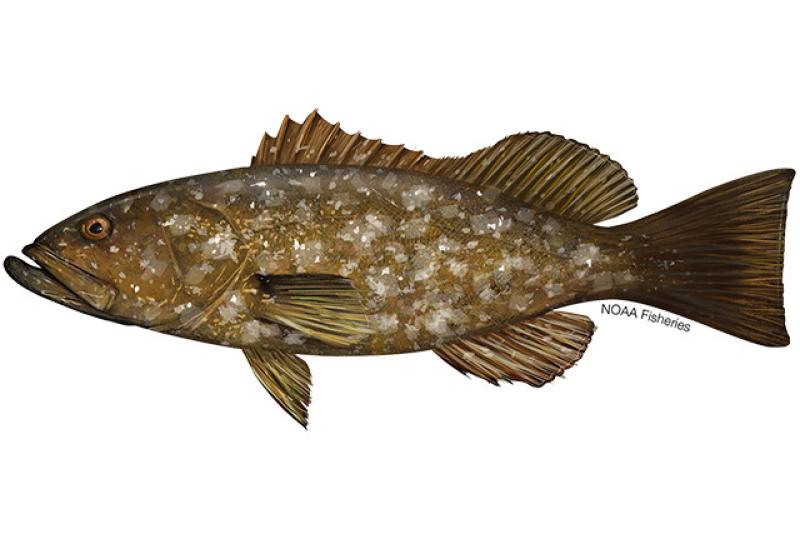Gulf Grouper
Mycteroperca jordani
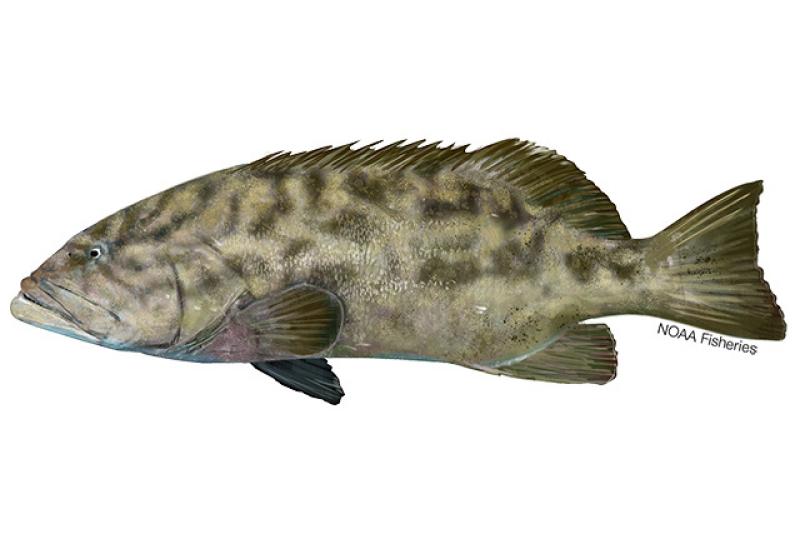
Protected Status
Quick Facts
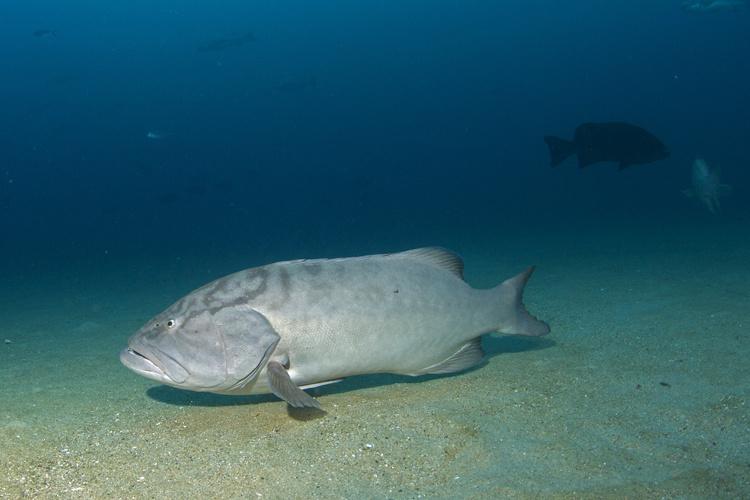 Gulf grouper. Credit: Octavio Aburto, Scripps Institution of Oceanography
Gulf grouper. Credit: Octavio Aburto, Scripps Institution of Oceanography
Gulf grouper. Credit: Octavio Aburto, Scripps Institution of Oceanography
About the Species
 Gulf grouper. Credit: Octavio Aburto, Scripps Institution of Oceanography
Gulf grouper. Credit: Octavio Aburto, Scripps Institution of Oceanography
Gulf grouper. Credit: Octavio Aburto, Scripps Institution of Oceanography
Gulf grouper are large fish that live in shallow, coastal areas including estuaries, bays, and mangroves as juveniles, before moving on to rocky reefs and kelp beds as adults. They are late-maturing, long-lived, top-level predators found from Mazatlán, Mexico, to the Gulf of California and rarely along the outer southern coast of Baja California.
Gulf grouper used to be common in the Gulf of California, but they became scarce because commercial and recreational fisherman could easily catch them. All harvest of gulf grouper is currently prohibited in the United States.
Gulf grouper are listed as endangered under the Endangered Species Act. NOAA Fisheries is dedicated to the conservation of gulf grouper. Our scientists use a variety of innovative techniques to study and protect this species.
Population Status
Gulf grouper were once considered abundant but are now considered rare. Their abundance has severely declined since the mid-20th century primarily because of direct harvest by commercial and artisanal fisheries. In the Gulf of California, gulf grouper were once abundant and represented approximately 45 percent of the artisanal fishery in 1960. This number declined to 10 percent by the 1970s, and gulf grouper now make up less than 1 percent of the fishery. Commercial landings of gulf grouper from the Pacific Ocean (U.S. vessels fishing in Mexican waters) peaked in the early 1950s before the population declined to near commercial extinction by 1970. Based on recent fishery independent surveys and fisheries data, the gulf grouper has not recovered and is still considered very rare in the Pacific Ocean portion of its range. Current gulf grouper distribution appears to be much more limited than their historical range.
Appearance
Gulf grouper are large and heavy-bodied. They are dark brown to gray.
Behavior and Diet
Gulf grouper eat many types of prey. They ambush and swallow prey whole using suction created by their protruding mouth. The size of their mouth determines the size and type of animal they eat. Adults eat only fish, while young grouper eat many different fish and invertebrates (e.g., shrimp and crabs).
Gulf grouper prefer to hunt at dawn and dusk when it is less bright and more prey are available. This timing could help them save energy when ambushing their prey.
Where They Live
Gulf grouper are found throughout the Gulf of California to Mazatlán, Sinaloa (Mexico). They are naturally rare north of Bahía Magdalena in southern Baja California. There are a few records from extreme southern California but these are considered waifs.
Young grouper inhabit shallow, coastal habitats, such as mangroves and estuaries. Adult gulf grouper are mainly found around rocky reefs, seamounts, and kelp beds. They inhabit waters 16 to 100 feet deep.
 World map providing approximate representation of the Gulf grouper's range.
World map providing approximate representation of the Gulf grouper's range.
Lifespan & Reproduction
Gulf grouper live for up to 48 years. Female gulf grouper become sexually mature when they are about 6 years old. Gulf grouper are also likely protogynous hermaphrodites which means that some or all individuals first mature as females and later transition into males.
Adult gulf grouper gather in small to large groups to reproduce. They gather at reefs and seamounts and form spawning aggregations from April to June. Historically, spawning aggregations involved hundreds of individuals, whereas only smaller aggregations of tens of individuals have been observed within marine reserves in recent years.
Threats
Bycatch
Gulf grouper become bycatch when they are harvested in a fishery but not sold or kept for personal use. Shrimp trawler fisheries sometimes catch juvenile gulf grouper by mistake.
Habitat Degradation
Habitat degradation threatens gulf grouper. Activities that may degrade their habitat include the release of contaminants, such as urban runoff, wastewater, or oil and gas spills. Pollution can also reduce the amount of oxygen in the water or deliver chemicals that are toxic to these fish.
Habitat Loss
Gulf grouper need healthy reefs to eat, reproduce, and grow, but development and chemical spills can destroy reefs. Physical barriers, such as shoreline and offshore development can also threaten gulf grouper by limiting their access to important breeding or feeding areas. Juvenile gulf grouper inhabit mangrove forests, which have been heavily impacted by coastal development and pollution in Mexico.
Overfishing
Direct harvest of gulf grouper, especially at spawning aggregation sites, is the biggest threat to the species. The life cycle of gulf grouper makes them especially vulnerable to overfishing. First, adult gulf grouper gather in large groups at the same time every year to reproduce. Because this behavior is so predictable, they become easy targets for fishermen. Additionally, gulf grouper likely start life as females but later transition into males. Fishermen often target males because they are older and larger than females. This means that there are fewer male groupers, which can reduce spawning activity and successful reproduction.
In areas with recreational fishing, fishermen catch gulf grouper. Even if these fishermen release grouper, they can still die from the injuries or stress caused by their capture.
Scientific Classification
| Kingdom | Animalia | Phylum | Chordata | Class | Actinopterygii | Order | Perciformes | Family | Epinephelidae | Genus | Mycteroperca | Species | jordani |
|---|
Last updated by NOAA Fisheries on 08/14/2025
Featured News
 Anglers identify signs of barotrauma on a red snapper. (Credit: Return ‘Em Right)
Anglers identify signs of barotrauma on a red snapper. (Credit: Return ‘Em Right)
Return ‘Em Right: Meet the People Helping Anglers Save Fish One Release at a Time
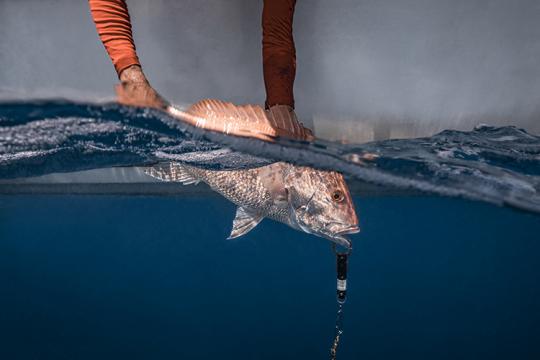
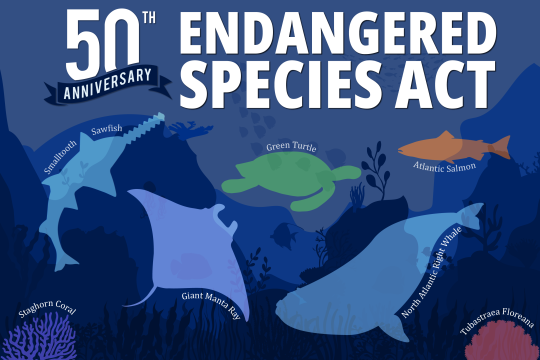
The Endangered Species Act: 50 Years of Conserving Species
 False killer whale jumping out of the water in the Northwestern Hawaiian Islands. Credit: Jim Cotton.
False killer whale jumping out of the water in the Northwestern Hawaiian Islands. Credit: Jim Cotton.
Management Overview
Gulf grouper is listed as endangered under the Endangered Species Act.

Conservation Efforts
Reducing Commercial and Recreational Fishing Impacts in the United States
There is currently no fishery for gulf grouper in the United States, where possession is prohibited. Gulf grouper may be caught incidentally as bycatch in various fisheries using hooks and lines, longlines, or traps.
Protecting Important Habitats
NOAA Fisheries protects important gulf grouper habitat through the ESA and the Magnuson-Stevens Fishery Conservation and Management Act. Working with these statutes, we can conserve important seagrass, mangrove, and reef habitats.
Regulatory History
In 2013, we received a petition from WildEarth Guardians to list the gulf grouper as threatened or endangered under the Endangered Species Act. On February 24, 2014, we published a notice that listing may be warranted for the gulf grouper and nine other fish species. We published the proposed rule to list the gulf grouper as endangered under the ESA on September 23, 2015. We published the final rule to list the gulf grouper as endangered under the ESA on October 20, 2016.
Key Actions and Documents
Last updated by NOAA Fisheries on 08/14/2025
Documents
Status Review of the Gulf Grouper (Mycteroperca jordani)
This status review of the gulf grouper (Mycteroperca jordani) will be presented in six sections…
Last updated by NOAA Fisheries on 08/14/2025

